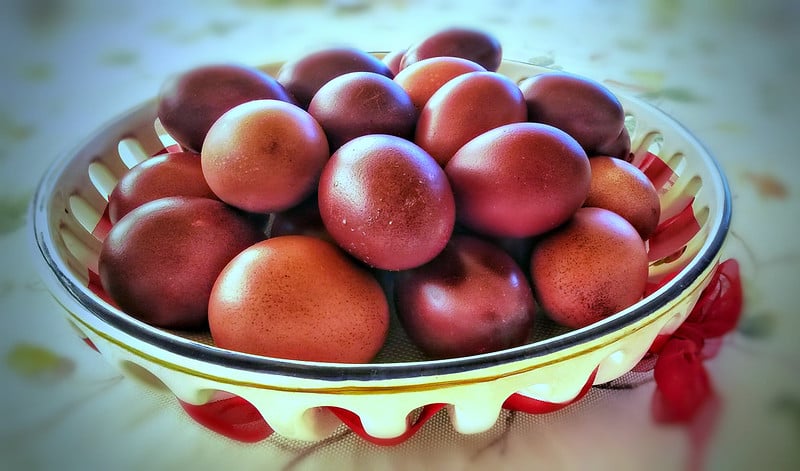
Traditionally, families across Greece dye eggs red on Holy Thursday. Dying eggs red in anticipation of Greek Easter is one of the oldest and most beloved traditions in Greece.
Along with candles, church services, lamb, and the sweet bread tsoureki, eggs that have been tinted with red dye are one of the most iconic symbols of Easter in Greece.
The symbolism of red eggs on Greek Easter
The red eggs hold significant religious symbolism, as the color red symbolizes the blood Christ shed on the cross.
Additionally, the egg in itself is a symbol — its hard shell represents the sealed tomb of Jesus — the cracking of which symbolizes His resurrection from the dead and exit from the tomb.
Due to its religious significance, the egg serves as an emblem of the resurrection, and its decorated Easter variations are globally recognized as a symbol of the most special day on the Christian calendar — Easter, the event that sealed the promise for eternal life.
According to some followers of Eastern Christianity, we owe the Easter tradition of painting eggs red on Holy Thursday to Mary Magdalene.
This tradition of some believers states that Mary Magdalene brought cooked eggs to share with the other women at the tomb of Jesus, and that the eggs in her basket miraculously turned brilliant red when she saw the risen Christ.
Others tell a similar story with just a few minor changes. According to tradition, Mary Magdalene, after stumbling upon Christ’s empty tomb, rushed to the Roman emperor to tell him the Christ had risen.
The emperor, however, didn’t believe what he was told and announced that he would believe Mary Magdalene’s claims only if the eggs in a basket next to him turned red, which they instantly did.
How to dye eggs red for Greek Easter naturally
In supermarkets in Greece and around the world, as Easter approaches, red dye is very east to find. But if you find yourself without red dye on Holy Thursday, or you’re looking to use a natural method, you can still make your eggs in time for Easter, as long as you have a few extra onions in the house.
In this video, acclaimed chef Peter Minakis shows how to naturally make your red Greek Easter eggs using onion skins. Here’s his secret organic recipe:

You will need:
the skins of approx. 10 medium yellow onions
5 cups of water
2 Tbsp. white vinegar
Eggs
Add your onion skins into a pot and pour enough water to cover them by over an inch. Bring up to a boil and then simmer for 30 minutes. Take off the heat and allow to cool to warm.
Remove the onion skins and place the eggs gently into the pot. Bring back to boil and simmer for 5 minutes then take off the heat.
Allow the eggs to cool in the red dye then transfer to your fridge to set overnight.
Remove the eggs with a slotted spoon and allow to air-dry (about 45 minutes).
Dab a white paper towel into some vegetable oil and polish then place in the egg carton and store in the fridge until needed.
Greeks crack the red-dyed eggs together on Easter
After the eggs have been dyed red, they are used to play the game tsougrisma on Easter Sunday.
Each player holds a red egg, and one taps the end of their egg against the end of the other player’s egg. The goal is to crack the opponent’s egg — without cracking yours, of course.
The player who successfully cracks the eggs of the other players is declared the winner and, it is said, will have good luck during the year.
Traditionally, when tapping the egg, the first player would say to his opponent “Christos anesti” (“Christ has risen!”), to which the second person responds “Alithos anesti!” (“He Truly Has”) as they return the tapping on their end.



Comments
Post a Comment